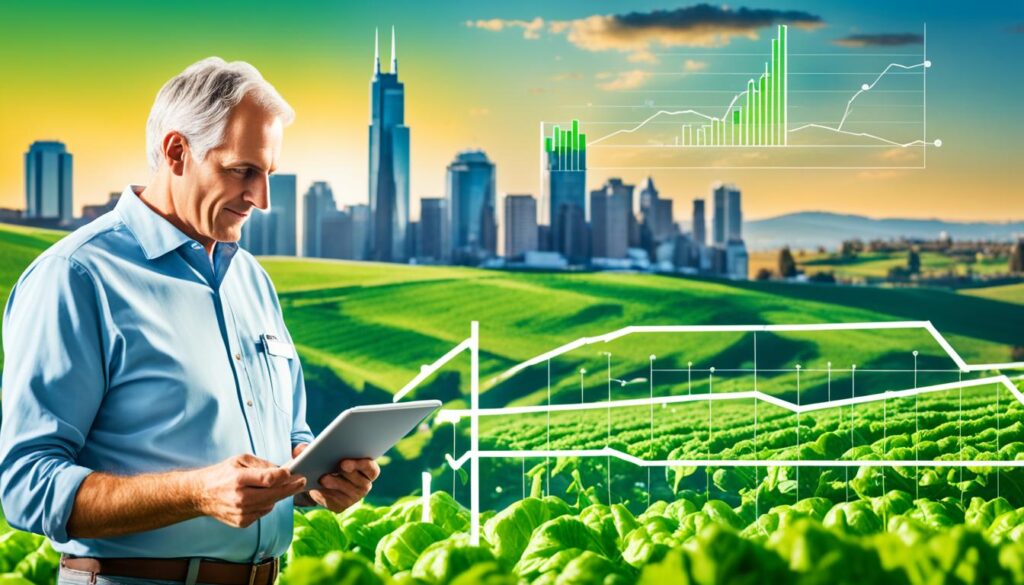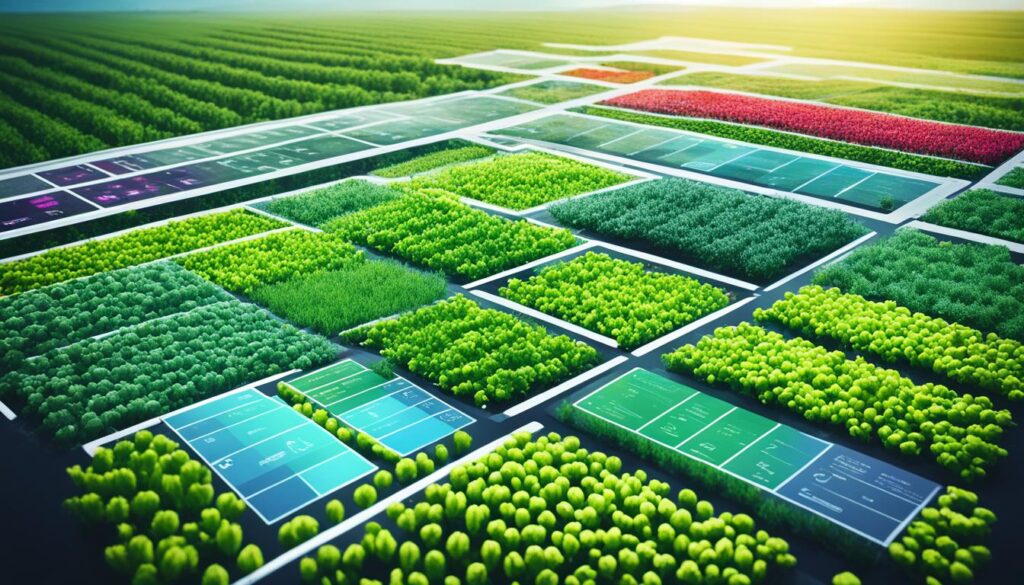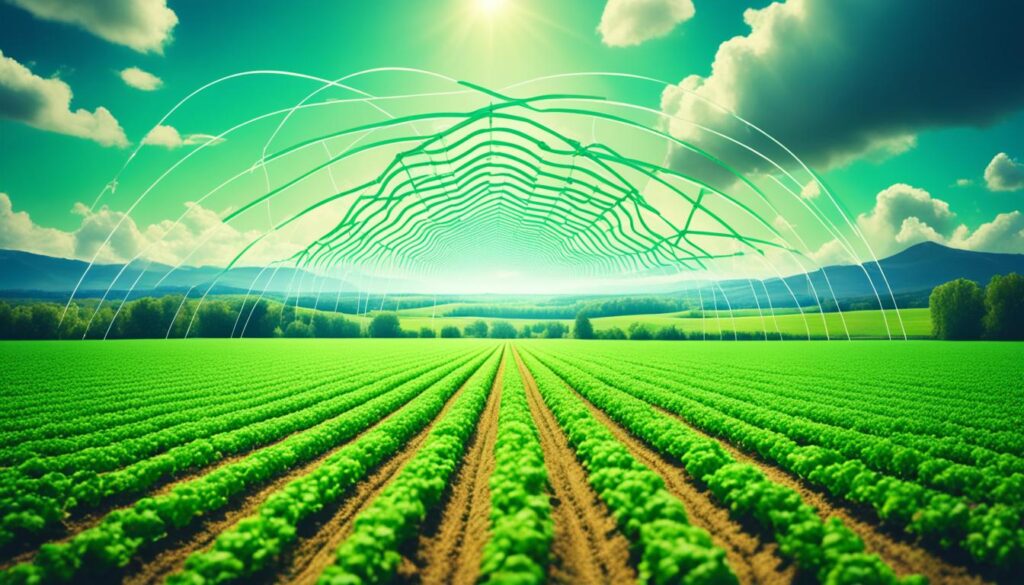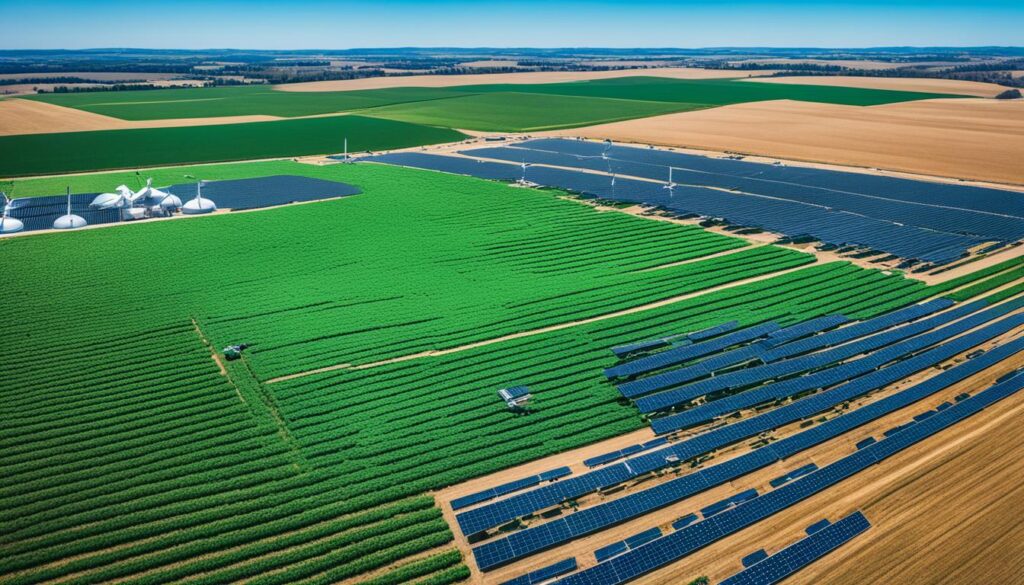The global population is projected to reach 9.8 billion by 2050, creating a pressing need for increased crop production. However, challenges like rapid urbanization and climate change have reduced available farmland, making it crucial to find innovative solutions. This is where big data and agricultural technology, or agtech, step in to revolutionize the industry.
By leveraging technologies like the Internet of Things (IoT) and advanced analytics, farmers can collect real-time data on weather conditions, soil quality, and crop health. This data can then be integrated with existing information and analyzed using predictive algorithms to optimize farming practices and boost crop yields. The adoption of data-driven agriculture is expected to grow significantly in the coming years, as it offers sustainable solutions for feeding a growing population.
Key Takeaways:
- Big data and agricultural technology can help address the challenge of increasing crop production to meet the needs of a growing population.
- By leveraging IoT and advanced analytics, farmers can collect and analyze real-time data to optimize farming practices and boost crop yields.
- The adoption of data-driven agriculture is expected to grow significantly in the coming years, offering sustainable solutions for food production.
- Big data enables farmers to make informed decisions based on granular data about weather patterns, soil conditions, and crop health.
- The integration of big data and agtech provides opportunities for innovation and sustainable farming practices.
How Big Data Can Help Agriculture
Big data plays a crucial role in transforming the agriculture industry, offering immense opportunities for optimizing farming practices and improving operational efficiency. By leveraging data collection, integration, and predictive algorithms, farmers can make data-driven decisions that lead to increased productivity and sustainable growth.
Data collection in agriculture is facilitated by Internet of Things (IoT) devices, such as sensors strategically placed in tractors, trucks, fields, soil, and plants. These devices capture valuable information that is essential for effective farm management. With the help of IoT technology, farmers can gather real-time data on weather conditions, soil quality, and crop health, among other variables.
Once the data is collected, it can be integrated with other relevant information, such as weather data and pricing models, to identify patterns, trends, and insights. This integration allows farmers to gain a holistic view of their operations and make informed decisions. For example, by analyzing historical weather patterns and comparing them with current conditions, farmers can adjust irrigation schedules and resource allocation to optimize crop growth.
“By leveraging big data technology, farmers can make data-driven decisions that lead to increased productivity and sustainable growth.”
Predictive algorithms play a crucial role in leveraging big data in agriculture. By analyzing historical data and identifying patterns, these algorithms can provide accurate forecasts and recommendations. For instance, predictive algorithms can predict optimal planting periods, helping farmers maximize crop yields and minimize losses.
The agricultural analytics market is witnessing steady growth, with a projected Compound Annual Growth Rate (CAGR) of 16.2% from 2018 to 2023. This growth is driven by the increasing adoption of analytics in agriculture and the industry’s recognition of data-driven decision-making as a powerful asset for driving productivity and profitability.
To illustrate the impact of big data in agriculture, consider the following table:
| Benefits of Big Data in Agriculture | Examples |
|---|---|
| Optimized resource allocation |
|
| Improved pest and disease management |
|
| Enhanced yield prediction |
|
As the table demonstrates, big data in agriculture offers a wide range of benefits, from optimized resource allocation to improved pest management and enhanced yield prediction. By tapping into the potential of big data, farmers can make proactive decisions that lead to higher crop yields, reduced costs, and sustainable agricultural practices.
Top Use Cases for Big Data in Agriculture
Big data has revolutionized the field of agriculture, offering various use cases that contribute to feeding a growing population, managing pesticides, optimizing farm equipment, and improving supply chain management. Let’s explore some of the key applications:
1. Feeding a Growing Population
With the global population on the rise, it is essential to maximize crop yields from existing farmlands. Big data provides farmers with critical insights through granular data on rainfall patterns, water cycles, and fertilizer requirements. By leveraging this data, farmers can make informed decisions to improve productivity and meet the demand for food.
2. Pesticide Management
Pesticides play a vital role in protecting crops from pests and diseases, but their excessive use can harm the environment and human health. Big data analytics helps address this issue by recommending the optimal application of pesticides based on data-driven insights. By reducing chemical overuse, farmers can minimize environmental impact while ensuring crop protection.
3. Farm Equipment Optimization
Effective management of farm equipment is crucial for optimizing productivity and minimizing downtime. Big data enables farmers to monitor equipment usage, track performance metrics, and receive alerts for maintenance and refueling. By leveraging these insights, farmers can improve operational efficiency and ensure that their machinery is operating at its peak performance.
4. Supply Chain Management
The agricultural supply chain is complex, involving multiple stakeholders and processes. Big data analytics helps manage supply chain issues by tracking and optimizing delivery routes, reducing transportation costs, and minimizing food waste. By improving the efficiency of the supply chain, farmers can ensure the timely delivery of fresh produce to meet consumer demands.
By harnessing the power of big data, the agriculture industry can address key challenges and unlock new opportunities for sustainable and efficient food production.

Case Studies: Big Data in Agriculture
Two case studies demonstrate the effective use of big data in agriculture. These examples showcase how companies like DTN and SMAG InVivo are harnessing data-driven insights to optimize farm management and increase crop yields.
DTN: Accessing Real-time Agricultural Information
DTN, a division of Schneider Electric, provides agricultural information solutions that enable farmers to access up-to-date weather and pricing data. By leveraging big data analytics, DTN empowers farmers to make informed decisions about crop planting, irrigation, and pest control. With real-time information, farmers can optimize their farming practices, improve yields, and enhance overall farm management.
SMAG InVivo: Precision Farming with Data-driven Insights
SMAG InVivo, a subsidiary of InVivo, embraces big data to drive precision farming practices. By pooling data from a variety of sources, including weather history, satellite and drone images, and soil types, SMAG InVivo employs sophisticated analytics to optimize decision-making. This approach allows farmers to tailor their crop management strategies based on precise data, resulting in increased crop yields and improved sustainability, particularly in wheat cultivation.
These case studies demonstrate that big data has the potential to revolutionize the agricultural industry by providing valuable insights and driving innovation. By leveraging data-driven solutions, farmers can optimize their practices, increase productivity, and contribute to sustainable food production.

The Role of cloud computing in Big Data Agriculture
Cloud computing plays a crucial role in revolutionizing the agriculture industry through its ability to provide ample computing power and storage for data analysis. By leveraging cloud-based technologies, farmers can harness the power of big data analytics to make informed decisions and optimize their farming practices.
One of the key advantages of cloud computing in big data agriculture is its capability to integrate various data sources into a centralized platform. Farmers can gather and analyze real-time data from sources such as weather stations, irrigation systems, and nutrient monitoring devices. This integration allows for a comprehensive understanding of the agricultural ecosystem, enabling farmers to make data-driven decisions regarding planting schedules, irrigation optimization, fertilizer application, and more.
Cloud-based applications further enhance the role of cloud computing in agriculture by providing farmers with tools to micromanage farming activities. These applications enable farmers to monitor crop growth, track field conditions, and estimate outcomes using data-driven insights. With the ability to access these applications from any location and device, farmers can make timely decisions to maximize productivity and efficiency.
Furthermore, cloud computing facilitates data-driven decision-making in farm management and supply chain optimization. By leveraging big data analytics, farmers can optimize farm operations and streamline the supply chain process to ensure efficient delivery of produce to market. This data-driven approach enables farmers to respond to market demand, reduce waste, and maximize profit margins.
Overall, cloud computing plays a crucial role in enabling big data analytics in agriculture, empowering farmers with the tools and insights needed to make informed decisions and drive sustainable farming practices.

| Benefits of Cloud Computing in Big Data Agriculture | Examples |
|---|---|
| Ample computing power and storage | Cloud platforms like AWS and Microsoft Azure provide scalable resources for handling large volumes of agricultural data. |
| Integration of diverse data sources | Farmers can integrate data from weather stations, IoT devices, and crop monitoring systems to gain a holistic view of their operations. |
| Remote access and real-time insights | Cloud-based applications allow farmers to access data and insights from anywhere, enabling them to make timely decisions to optimize farm activities. |
| Optimized farm management and supply chain | By leveraging cloud-based analytics, farmers can optimize farming practices and streamline the supply chain for improved efficiency and profitability. |
| Scalability and cost-effectiveness | Cloud computing offers flexible resources, allowing farmers to scale their infrastructure based on changing needs, while reducing costs compared to on-premises solutions. |
Getting Started with Big Data in Agriculture
To fully harness the power of big data in agriculture, a cloud-based ecosystem with robust tools and software for data integration is essential. By consolidating data on climate, agronomy, water, farm equipment, supply chain, and more, these tools aid farmers in making informed decisions to optimize their operations and maximize yields. One such suite of self-service apps that excels in this regard is Talend Data Fabric.

A Cloud-Based Ecosystem for Agricultural Data Integration
Talend Data Fabric offers a comprehensive solution for integrating and analyzing data in the agricultural industry. Its powerful capabilities enable farmers to leverage the full potential of their data, improving efficiency and driving innovation.
“Talend Data Fabric allows farmers to consolidate and streamline data from various sources, enabling them to make data-driven decisions that optimize their farming practices.”
With Talend Data Fabric, farmers can integrate data from sensors, weather APIs, historical databases, equipment systems, and supply chain networks. By bringing together these disparate data sources, farmers gain a holistic view of their agricultural operations, facilitating better decision-making at every stage of the farming process.
The Benefits of Talend Data Fabric
Talend Data Fabric offers a range of benefits tailored to the needs of the agriculture industry:
- Seamless Data Integration: Talend Data Fabric enables the smooth integration of diverse data sources, ensuring that all relevant information is readily available for analysis.
- Real-Time Insights: This powerful tool provides farmers with real-time insights into weather conditions, soil quality, equipment performance, and supply chain dynamics, allowing them to make proactive decisions to optimize crop yield and resource utilization.
- Predictive Analytics: By leveraging predictive algorithms, Talend Data Fabric helps farmers anticipate challenges and assess potential risks, enabling them to take preventative measures and improve the overall efficiency and profitability of their farming operations.
- Scalability and Flexibility: With its cloud-based architecture, Talend Data Fabric offers unlimited scalability, allowing farmers to seamlessly handle growing volumes of data as their operations expand. Additionally, it provides flexible deployment options, giving farmers the freedom to choose the hosting environment that best suits their needs.
| Benefits of Talend Data Fabric | Description |
|---|---|
| Seamless Data Integration | Talend Data Fabric enables the smooth integration of diverse data sources, ensuring that all relevant information is readily available for analysis. |
| Real-Time Insights | This powerful tool provides farmers with real-time insights into weather conditions, soil quality, equipment performance, and supply chain dynamics, allowing them to make proactive decisions to optimize crop yield and resource utilization. |
| Predictive Analytics | By leveraging predictive algorithms, Talend Data Fabric helps farmers anticipate challenges and assess potential risks, enabling them to take preventative measures and improve the overall efficiency and profitability of their farming operations. |
| Scalability and Flexibility | With its cloud-based architecture, Talend Data Fabric offers unlimited scalability, allowing farmers to seamlessly handle growing volumes of data as their operations expand. Additionally, it provides flexible deployment options, giving farmers the freedom to choose the hosting environment that best suits their needs. |
Challenges and Opportunities of Data Analytics in Agriculture
Implementing data analytics in agriculture presents both challenges and opportunities that can shape the future of the industry. These challenges include ensuring data accessibility for all farmers and integrating data from diverse sources. Collaboration among stakeholders and the development of industry-standard data sharing architectures are crucial in overcoming these hurdles. Additionally, data privacy must be addressed to establish trust and confidence among farmers and other stakeholders in the use of data analytics for agricultural decision-making.
Despite these challenges, the integration of data analytics in agriculture opens up immense opportunities for innovation and sustainable food production. By harnessing the power of data accessibility and integration, farmers can make informed decisions to optimize crop yields, minimize environmental impact, and enhance the efficiency of the agricultural supply chain. The future of data analytics in agriculture holds great potential to revolutionize the industry and contribute to a more food-secure and sustainable world.
Collaboration: Overcoming Data Accessibility and Integration Challenges
Collaboration among farmers, researchers, technology providers, and policymakers is essential in addressing the challenges of data accessibility and integration in agriculture. By working together, they can develop standardized protocols and platforms for data sharing and ensure that all farmers have access to the data necessary for making informed decisions. This collaboration can also lead to the creation of innovative solutions that enable seamless integration of data from various sources, such as weather data, soil composition, and crop performance.
“Collaboration among stakeholders, including farmers, researchers, and technology providers, is crucial in overcoming the challenges of data accessibility and integration in agriculture.”
Data Privacy: Building Trust in Data Analytics
Data privacy is a critical concern in the implementation of data analytics in agriculture. Farmers and stakeholders need assurance that their data is protected and will be used solely for the intended purposes. Robust data privacy policies and safeguards should be put in place to address these concerns, ensuring transparency and accountability throughout the data analytics process. By prioritizing data privacy, the industry can build trust and confidence among farmers, encouraging broader adoption of data-driven decision-making practices.
Opportunities for Innovation and Sustainable Food Production
The integration of data analytics in agriculture presents numerous opportunities for innovation and sustainable food production. By leveraging data accessibility and integration, farmers can optimize resource allocation, improve crop yields, and minimize environmental impact. Data-driven insights can also enable precision farming techniques, allowing farmers to tailor their practices to specific crop needs, resulting in more efficient use of fertilizers, pesticides, and water. Furthermore, data analytics can contribute to the development of sustainable supply chain management strategies, minimizing food waste and reducing the carbon footprint of the agricultural industry.
| Challenges | Opportunities |
|---|---|
| Data Accessibility | Innovation in decision-making |
| Data Integration | Efficient resource allocation |
| Collaboration | Improved crop yields |
| Data Privacy | Sustainable food production |
With the relentless growth of data and advances in technology, the future of data analytics in agriculture holds immense potential. By addressing challenges related to data accessibility, integration, collaboration, and privacy, the industry can unlock innovative solutions that drive sustainable food production. Data-driven decision-making in agriculture paves the way for a more efficient, environmentally friendly, and resilient agricultural sector, ensuring food security for the growing global population.
Conclusion
Data analytics is revolutionizing the agriculture sector, bringing about significant improvements in productivity, efficiency, and sustainability. Through the implementation of precision agriculture, predictive analytics, and sustainable farming practices, driven by big data, we are witnessing enhanced crop yields, reduced environmental impact, and optimized agricultural supply chains. As technology continues to advance and data integration becomes more seamless, the future of agriculture holds immense potential for harnessing data-driven approaches to ensure a more food-secure and sustainable world.
Big data in agriculture has proven to be a game-changer, empowering farmers to make data-driven decisions that lead to increased yields and improved resource management. By leveraging the power of data, farmers can obtain valuable insights into weather patterns, soil conditions, and market demand, allowing for smarter planting choices and precise resource allocation. These data-driven farming practices not only contribute to sustainable food production but also play a vital role in minimizing waste and promoting efficient use of water, fertilizers, and pesticides.
Furthermore, big data analytics facilitates the optimization of the entire agricultural supply chain. By tracking and analyzing data points from farm to market, we can streamline processes, reduce food waste, and ensure timely delivery of produce. Collaboration among industry stakeholders, coupled with the development of industry-standard data sharing architectures, will be crucial in overcoming challenges related to data accessibility and integration. Additionally, prioritizing data privacy and security measures will foster trust among farmers and stakeholders, enabling the widespread adoption of data analytics in agriculture.
As we embrace innovative technologies and embrace the possibilities provided by big data, the agricultural industry stands at the forefront of sustainable food production. Through the combined efforts of farmers, technologists, and policymakers, data-driven approaches have the potential to revolutionize agriculture and create a future where food security and environmental sustainability go hand in hand. By harnessing the power of big data, we can build a resilient and thriving agricultural sector that supports the growing global population, while safeguarding our planet for generations to come.
FAQ
How can big data help agriculture?
Big data in agriculture enables farmers to collect and analyze real-time data on weather and soil conditions, integrate it with existing information, and use predictive algorithms to optimize farming practices for increased efficiency and productivity.
What are some use cases for big data in agriculture?
Big data can be used to improve yield from existing farmlands by providing granular data on rainfall patterns, water cycles, and fertilizer requirements. It can also assist in pesticide management, optimize farm equipment usage, and help manage supply chain issues to reduce food waste.
Can you provide any case studies of big data in agriculture?
Two notable case studies are DTN, a division of Schneider Electric, which provides agricultural information solutions to help farmers access up-to-date weather and pricing data for better farm management and improved yields, and SMAG InVivo, a subsidiary of InVivo, which uses big data to enable precision farming and optimize crop yields, especially in wheat cultivation.
What is the role of cloud computing in big data agriculture?
Cloud computing plays a crucial role in big data agriculture by providing ample computing power and storage for data analysis. It enables the integration of various data sources, such as weather, irrigation, and nutrient requirements, to guide farmers’ decisions on planting, production adjustments, and market demand.
How can farmers get started with big data in agriculture?
To get started with big data in agriculture, farmers should look for a cloud-based ecosystem with robust tools and software for data integration. This ecosystem should be capable of consolidating data on climate, agronomy, water, farm equipment, and supply chain to aid in decision-making. Talend Data Fabric is one such suite of self-service apps that can help farmers stream data from multiple sources in real-time and provide crucial insights based on high-quality data.
What are the challenges and opportunities of data analytics in agriculture?
Some challenges of implementing data analytics in agriculture include ensuring data accessibility for all farmers and integrating data from various sources. These challenges can be overcome through collaboration and the development of industry-standard data sharing architectures. Additionally, data privacy must be addressed to ensure farmers’ and stakeholders’ trust in data analytics. Despite these challenges, the future of data analytics in agriculture holds immense opportunities for innovation and sustainable food production.
How does big data revolutionize the agriculture sector?
Big data analytics is revolutionizing the agriculture sector by improving productivity, efficiency, and sustainability. Precision agriculture, predictive analytics, and sustainable farming practices driven by big data are enhancing crop yields, reducing environmental impact, and optimizing the agricultural supply chain.








